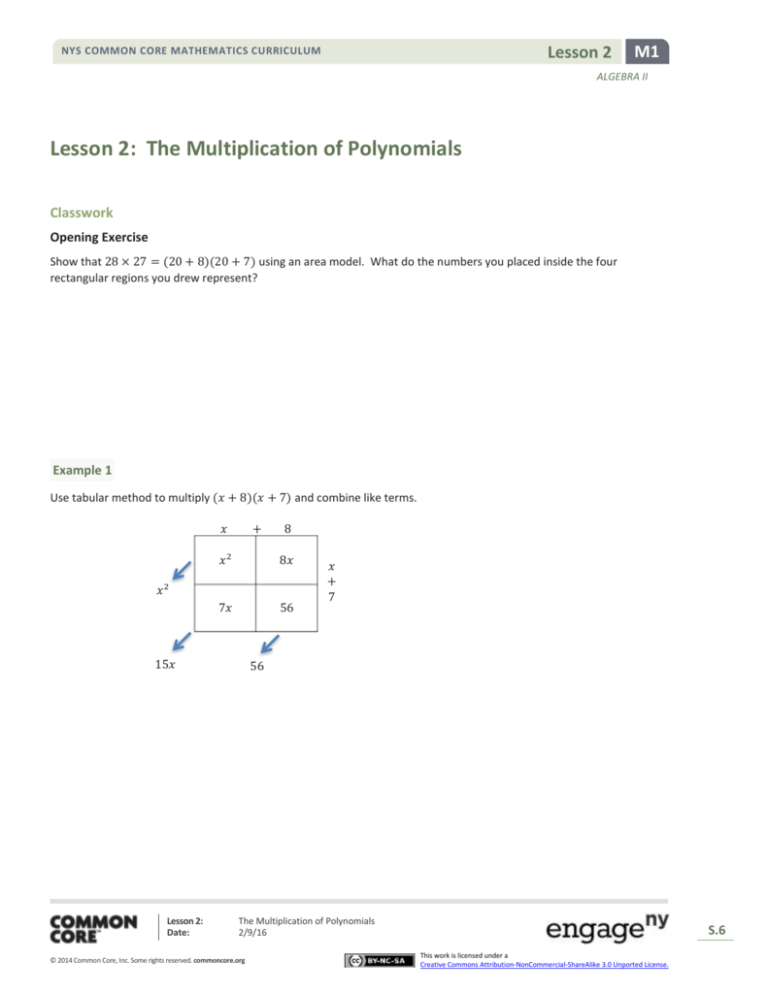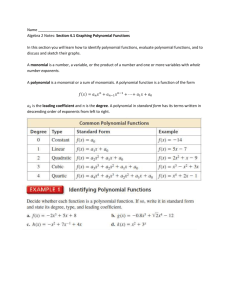
Lesson 2
NYS COMMON CORE MATHEMATICS CURRICULUM
M1
ALGEBRA II
Lesson 2: The Multiplication of Polynomials
Classwork
Opening Exercise
Show that 28 × 27 = (20 + 8)(20 + 7) using an area model. What do the numbers you placed inside the four
rectangular regions you drew represent?
Example 1
Use tabular method to multiply (𝑥 + 8)(𝑥 + 7) and combine like terms.
𝑥
+
8
𝑥2
8𝑥
7𝑥
56
𝑥2
15𝑥
Lesson 2:
Date:
𝑥
+
7
56
The Multiplication of Polynomials
2/9/16
© 2014 Common Core, Inc. Some rights reserved. commoncore.org
S.6
This work is licensed under a
Creative Commons Attribution-NonCommercial-ShareAlike 3.0 Unported License.
Lesson 2
NYS COMMON CORE MATHEMATICS CURRICULUM
M1
ALGEBRA II
Exercises 1–2
1.
Use the tabular method to multiply (𝑥 2 + 3𝑥 + 1)(𝑥 2 − 5𝑥 + 2) and combine like terms.
2.
Use the tabular method to multiply (𝑥 2 + 3𝑥 + 1)(𝑥 2 − 2) and combine like terms.
Lesson 2:
Date:
The Multiplication of Polynomials
2/9/16
© 2014 Common Core, Inc. Some rights reserved. commoncore.org
S.7
This work is licensed under a
Creative Commons Attribution-NonCommercial-ShareAlike 3.0 Unported License.
NYS COMMON CORE MATHEMATICS CURRICULUM
Lesson 2
M1
ALGEBRA II
Example 2
Multiply the polynomials (𝑥 − 1)(𝑥 4 + 𝑥 3 + 𝑥 2 + 𝑥 + 1) using a table. Generalize the pattern that emerges by writing
down an identity for (𝑥 − 1)(𝑥 𝑛 + 𝑥 𝑛−1 + ⋯ + 𝑥 2 + 𝑥 + 1) for 𝑛 a positive integer.
𝑥5
0𝑥
4
0𝑥 3
0𝑥
2
0𝑥
𝑥
−1
𝑥5
−𝑥 4
𝑥4
𝑥4
−𝑥 3
𝑥3
𝑥3
−𝑥 2
𝑥2
𝑥2
−𝑥
𝑥
𝑥
−1
1
−1
Exercises 3–4
3.
Multiply (𝑥 − 𝑦)(𝑥 3 + 𝑥 2 𝑦 + 𝑥𝑦 2 + 𝑦 3 ) using the distributive property and combine like terms. How is this
calculation similar to Example 2?
4.
Multiply (𝑥 2 − 𝑦 2 )(𝑥 2 + 𝑦 2 ) using the distributive property and combine like terms. Generalize the pattern that
emerges to write down an identity for (𝑥 𝑛 − 𝑦 𝑛 )(𝑥 𝑛 + 𝑦 𝑛 ) for positive integers 𝑛.
Lesson 2:
Date:
The Multiplication of Polynomials
2/9/16
© 2014 Common Core, Inc. Some rights reserved. commoncore.org
S.8
This work is licensed under a
Creative Commons Attribution-NonCommercial-ShareAlike 3.0 Unported License.
Lesson 2
NYS COMMON CORE MATHEMATICS CURRICULUM
M1
ALGEBRA II
Relevant Vocabulary
Equivalent Polynomial Expressions: Two polynomial expressions in one variable are equivalent if, whenever a number is
substituted into all instances of the variable symbol in both expressions, the numerical expressions created are equal.
Polynomial Identity: A polynomial identity is a statement that two polynomial expressions are equivalent. For example,
(𝑥 + 3)2 = 𝑥 2 + 6𝑥 + 9 for any real number 𝑥 is a polynomial identity.
Coefficient of a Monomial: The coefficient of a monomial is the value of the numerical expression found by substituting
the number 1 into all the variable symbols in the monomial. The coefficient of 3𝑥 2 is 3, and the coefficient of the
monomial (3𝑥𝑦𝑧) ⋅ 4 is 12.
Terms of a Polynomial: When a polynomial is expressed as a monomial or a sum of monomials, each monomial in the
sum is called a term of the polynomial.
Like Terms of a Polynomial: Two terms of a polynomial that have the same variable symbols each raised to the same
power are called like terms.
Standard Form of a Polynomial in One Variable: A polynomial expression with one variable symbol, 𝑥, is in standard
form if it is expressed as
𝑎𝑛 𝑥 𝑛 + 𝑎𝑛−1 𝑥 𝑛−1 + ⋯ + 𝑎1 𝑥 + 𝑎0 ,
where 𝑛 is a non-negative integer, and 𝑎0 , 𝑎1 , 𝑎2 … , 𝑎𝑛 are constant coefficients with 𝑎𝑛 ≠ 0.
A polynomial expression in 𝑥 that is in standard form is often just called a polynomial in 𝑥 or a polynomial.
The degree of the polynomial in standard form is the highest degree of the terms in the polynomial, namely 𝑛. The term
𝑎𝑛 𝑥 𝑛 is called the leading term and 𝑎𝑛 (thought of as a specific number) is called the leading coefficient. The constant
term is the value of the numerical expression found by substituting 0 into all the variable symbols of the polynomial,
namely 𝑎0 .
Problem Set
1.
Complete the following statements by filling in the blanks.
a.
(𝑎 + 𝑏)(𝑐 + 𝑑 + 𝑒) = 𝑎𝑐 + 𝑎𝑑 + 𝑎𝑒 + ____ + ____ + ____
b.
(𝑟 − 𝑠)2 = (
c.
(2𝑥 + 3𝑦)2 = (2𝑥)2 + 2(2𝑥)(3𝑦) + (
d.
(𝑤 − 1)(1 + 𝑤 + 𝑤 2 ) =
2
)𝑟𝑠 + 𝑠 2
) −(
2
𝑎 − 16 = (𝑎 +
f.
(2𝑥 + 5𝑦)(2𝑥 − 5𝑦) =
g.
(221
h.
[(𝑥 − 𝑦) − 3][(𝑥 − 𝑦) + 3] = (
− 1)(2
)(𝑎 −
)
−
+ 1) =
Lesson 2:
Date:
2
−1
e.
21
)
− 1
2
) − 9
The Multiplication of Polynomials
2/9/16
© 2014 Common Core, Inc. Some rights reserved. commoncore.org
S.9
This work is licensed under a
Creative Commons Attribution-NonCommercial-ShareAlike 3.0 Unported License.
Lesson 2
NYS COMMON CORE MATHEMATICS CURRICULUM
M1
ALGEBRA II
2.
3.
Use the tabular method to multiply and combine like terms.
a.
(𝑥 2 − 4𝑥 + 4)(𝑥 + 3)
b.
(11 − 15𝑥 − 7𝑥 2 )(25 − 16𝑥 2 )
c.
(3𝑚3 + 𝑚2 − 2𝑚 − 5)(𝑚2 − 5𝑚 − 6)
d.
(𝑥 2 − 3𝑥 + 9)(𝑥 2 + 3𝑥 + 9.
Multiply and combine like terms to write as the sum or difference of monomials.
b.
𝑥 3 (𝑥 + 6) + 9
(96𝑧 + 24𝑧 2 )
d.
223 (284 − 281 )
e.
(𝑥 − 4)(𝑥 + 5)
f.
(10𝑤 − 1)(10𝑤 + 1)
g.
(3𝑧 2 − 8)(3𝑧 2 + 8)
h.
(−5𝑤 − 3)𝑤 2
i.
8𝑦1000 (𝑦12200 + 0.125𝑦)
j.
(2𝑟 + 1)(2𝑟 2 + 1)
k.
(𝑡 − 1)(𝑡 + 1)(𝑡 2 + 1)
l.
(𝑤 − 1)(𝑤 5 + 𝑤 4 + 𝑤 3 + 𝑤 2 + 𝑤 + 1)
n.
𝑛(𝑛 + 1)(𝑛 + 2)
p.
𝑛(𝑛 + 1)(𝑛 + 2)(𝑛 + 3)(𝑛 + 4)
a.
c.
2𝑎(5 + 4𝑎)
1
8
m. (𝑥+2)(𝑥+2)(𝑥+2)
o.
4.
5.
6.
𝑛(𝑛 + 1)(𝑛 + 2)(𝑛 + 3)
3
2
q.
(𝑥 + 1)(𝑥 − 𝑥 + 𝑥 − 1)
r.
(𝑥 + 1)(𝑥 5 − 𝑥 4 + 𝑥 3 − 𝑥 2 + 𝑥 − 1)
s.
(𝑥 + 1)(𝑥 7 − 𝑥 6 + 𝑥 5 − 𝑥 4 + 𝑥 3 − 𝑥 2 + 𝑥 − 1)
t.
(𝑚3 − 2𝑚 + 1)(𝑚2 − 𝑚 + 2)
Polynomial expressions can be thought of as a generalization of place value.
a.
Multiply 214 × 112 using the standard paper-and-pencil algorithm.
b.
Multiply (2𝑥 2 + 𝑥 + 4)(𝑥 2 + 𝑥 + 2) using the tabular method and combine like terms.
c.
Put 𝑥 = 10 into your answer from part (b).
d.
Is the answer to part (c) equal to the answer from part (a)? Compare the digits you computed in the algorithm
to the coefficients of the entries you computed in the table. How do the place-value units of the digits
compare to the powers of the variables in the entries?
Jeremy says (𝑥 − 9)(𝑥 7 + 𝑥 6 + 𝑥 5 + 𝑥 4 + 𝑥 3 + 𝑥 2 + 𝑥 + 1) must equal 𝑥 7 + 𝑥 6 + 𝑥 5 + 𝑥 4 + 𝑥 3 + 𝑥 2 + 𝑥 + 1
because when 𝑥 = 10, multiplying by 𝑥 − 9 is the same as multiplying by 1.
a.
Multiply (𝑥 − 9)(𝑥 7 + 𝑥 6 + 𝑥 5 + 𝑥 4 + 𝑥 3 + 𝑥 2 + 𝑥 + 1).
b.
Put 𝑥 = 10 into your answer.
c.
Is the answer to part (b) the same as the value of 𝑥 7 + 𝑥 6 + 𝑥 5 + 𝑥 4 + 𝑥 3 + 𝑥 2 + 𝑥 + 1 when 𝑥 = 10?
d.
Was Jeremy right?
In the diagram, the side of the larger square is 𝑥 units and the side of the
smaller square is 𝑦 units. The area of the shaded region is (𝑥 2 − 𝑦 2 ) square
units. Show how the shaded area might be cut and rearranged to illustrate
that the area is (𝑥 − 𝑦)(𝑥 + 𝑦) square units.
Lesson 2:
Date:
𝑥
𝑦
The Multiplication of Polynomials
2/9/16
© 2014 Common Core, Inc. Some rights reserved. commoncore.org
S.10
This work is licensed under a
Creative Commons Attribution-NonCommercial-ShareAlike 3.0 Unported License.








